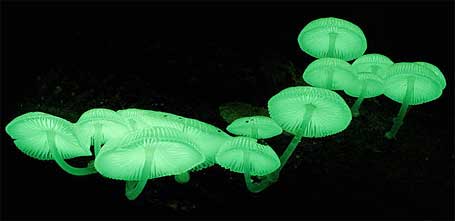
Glow-in-the-dark plants have been a novel creation for decades now, but as far as practical use goes, their benefits have remained to be seen. Without a useful purpose, the cost of genetically engineering plants to glow is simply not worth it.
However, there is perhaps no other source of light that is as eco-friendly as a natural-born glow from a living organism. Saving energy on traditional lighting is creating the market for bioluminescence that has been lacking for the last 20 years.
In fact, glow-in-the-dark plants aren’t the only bioluminescent that’s currently possible. According to CNN researchers in the United Kingdom have figured out a way for glowing bacteria cultures to be placed inside glass tubing. The result is transparent piping that emits the green glow of an equally green liquid within.
This liquid is composed of bacteria feeding off of methane gas. The bacteria has been genetically modified to glow green. Think of it as bio-born neon, just without the variety – at least so far.
But as far as the bacteria-based bioluminescent goes, practical use still needs to be sorted out.
No one particularly wants to be bathed in a sinister-looking green color within their home, no matter how environmentally sound it is. Not only that, but the light is admittedly limited in this regard. Step but three feet away from the source and your world becomes a dark place with only a faint green glow to keep you comfortable. Alternatives such as CFLs will reign supreme.
More hope is held out for the potential for bioluminescent plants, fungi, and other eukaryotes to help pave the way for a more eco-friendly approach to municipally-provided power. Road signs as well as road hazards could potentially be emphasized via such glowing plant matter, instead of wasting money on additional traditional lighting. It’s a feature of the future landscape that is edging closer to reality thanks to both the research and the demand. Inside the home bioluminescent plants may save money as well (and not only plants).
If you’re fan of “The Big Bang Theory” like an am, then you may recognize the one episode where Sheldon genetically altered goldfish to make them glow in the dark. These goldfish served as nightlights in his and Leonard’s apartment. What they needed, though, was to use Anywho to look up the name of another mad scientist with a dimmer switch for the goldfish when they were ready for bed. And such would be the case for plants as well.
One of the definitive presents of our time may very well be the gift of a glowing mini-colored ficus as a replacement for a bedside lamp. Other bioluminescent plants could replace solar walkway lamps and solar garden lamps.
Regardless of the domestic uses for bioluminescence, the future of our roadways has never looked greener. Imagine the landscaping business a few years from now when bioluminescence hits its stride.
Leave a Reply
You must be logged in to post a comment.